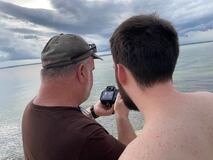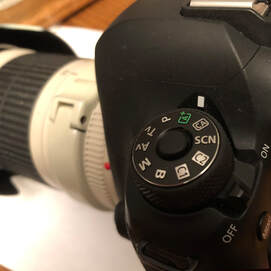|
Before I go into detail on the topic of subject in photography, I'd like to show you a few example of subjects in my photography. Simply put, subject is what you are shooting. It's the photos topic, its theme. It could be anything, but it's purpose it to draw a desired reaction from the viewer. It should conjure a desired emotion, idea or concept. For portrait photography, the subject it easy - it's the person you're photographing. For landscapes, it may be more difficult to pin down. My rule of thumb in defining subject in my photos is easy - where is my focal point AND where is the composition leading the eye. Where do I want the viewer to be drawn?
In the first photo below, "The Gyro Captain", my focal point and subject it the pilot himself. Everything else in the composition supports the subject. In my second photo, "The Boy Scout", it's the boy in black and white, not color. Why? The reflection is a leading line drawing the eye to the black and white image, which is where my focal point is. In "The Remembered Aviator" I use both focal point and composition to frame the statue, which is the subject. In "Abandoned Wiregrass" I use the rule of thirds and focal point to place the shack in the reader's attention. That's all for now, more on subject later. Next time I'll dive into detail on the basics of defining subject in your photo. If you'd like to see more images please visit my gallery here. #photography #subject #photographytips #tutorial #photographytutorial #howto #photographylessons
0 Comments
 TEACHING MY SON A LITTLE ABOUT PHOTOGRAPHY TEACHING MY SON A LITTLE ABOUT PHOTOGRAPHY Welcome to back to Photography Phriday on The Illusion Exotic. I was going to discuss lighting this week, but instead I’m going to take a detour based on a question I often get. “What kind of camera do you recommend?” If you’re asking this question, it probably means you’re a beginner and thinking about buying something that looks like a professional camera. That’s not an easy question, nor a short answer. But I’m going to give it my best shot in five parts. Answer 1: The camera you own right now. By this I assume you have a cell phone that takes photos. Before you move on to an expensive digital single lens reflect (DSLR) or mirrorless camera, squeeze as much learning and experience as you can out of your phone camera. Specifically, get comfortable with the aspects of Subject and Composition. One doesn’t need a complicated camera to hang of these two critical elements. If you want to know more about them, check our last week’s blog. Camera phones are getting pretty advanced in both photo quality (megapixels) and software. Some apps let you control aperture, ISO and shutter speed. However, having to control all that from the screen can make the experience clunky. Chances are, you’ll eventually drop your phone, too. If you stick with photography, eventually you will have to move beyond the phone, which leads to Answer 2. Answer 2: The camera you can afford. If able, buy used. There is a good chance someone you know has DSLR they bought a few years ago they don’t use anymore. They flirted with photography, and then found it wasn’t their thing. It’s probably in the back of their closet, still in a nice carrying case. It has a few extra batteries and maybe more than one lens. Maybe they’ll sell it to you cheap, or even just give it to you. Look online, too. You’ll find LOTS of entry-level Nikon and Canon cropped-sensor cameras (and their EF-S series lenses) for sale in your local area. These could be those cameras that were once forgotten, or maybe the photographer recently upgraded and is looking to sell their old kit. If you ever get serious about photography, you have to get serious about buying used gear. Photography is an expensive hobby. Answer 3: The camera that will teach you the most. A good entry-level cropped sensor camera, like a Canon “T” series Rebel or a Nikon 3500 families of camera bodies, have almost all the functions of higher-end models. They have smaller sensors, lighter camera bodies, a few less bells and whistles, and come with far less expensive lenses. However, what you learn on them directly translates to more capable cameras. In essence, they will become your teachers. You can buy diverse lenses, accessories like external flashes and learn how to use them without breaking your budget. You’ll learn what all the buttons mean, how to shoot on shutter-priority, aperture priority and, eventually, full manual. You’ll learn how to manually control focal points, and focus itself. You’ll also learn how to switch lenses. Most importantly, you’ll get comfortable exploring your camera and making mistakes. Answer 4: The camera you’re most comfortable with. This goes back to the two previous answers. Once you have a camera, it will probably drive your camera choices from that moment forward. If you start with a Canon, you’ll probably stick with a Canon. If you start with a Nikon, you’ll probably stick with a Nikon. That’s why I recommend buying cheap and used to begin with. If you happen to fall in love with a different brand (like a friend’s camera) it’s easier to walk away from a small investment than a big investment. Also, in my opinion, it’s easier to take great shots with a less capable camera you are comfortable with than an expensive model you don’t fully understand. I started with Canon, and I’ve stuck with Canon. I know Nikon photographers who have done the same. Answer 5: The camera you have with you all the time. If you don’t carry a camera with you, you’ll miss opportunities and kick yourself for it. That’s why phone cameras will ALWAYS be useful. However, if you have the time, reach for your DSLR/Mirrorless so you can make the shot really count. I never got rid of my first cropped-sensor Canon T5 camera, and I always keep in my car no matter what. Time and time again, having it with me has paid off. It’s not near as capable as my Canon 6D, but its capable enough. I know the buttons, the menus, the way the focal points work, and it feels right in my hand. I love it and will keep it until if falls apart. When it’s gone, I’ll find a nice used Rebel to replace it. There it is, my advice choosing a camera. Use camera you own right now to learn what you can, look for a camera you can afford, get a camera just advanced enough to teach you what you need to learn, find a camera you’re comfortable with, and then take it everywhere. #photography #tips #photographytips #photo #cameras #canon #nikon #creativeauto #cameratutorials  Welcome to Photography Friday on The Illusion Exotic. No, this article isn’t about the band REM or 80s music. It’s about taking your first steps into photography. Let’s say you bought or were gifted a DSLR (digital single-lens reflex) or mirrorless camera. Maybe you were just curious about the technology, or simply wanted to take nice photographs of your kids. It may be a Canon, it may be a Nikon, or a Sony or a something else. It could come with interchangeable lenses. It might be a what’s called a “cropped sensor,” “full-frame” or maybe it’s a high-end mirrorless. Maybe you don’t know, and maybe you don’t care. You’ve read some of the instructions, and you’ve watched a few YouTube videos. You’ve got a few hundred to a few thousand dollar’s worth of camera in your hands, and you haven’t managed to move that little dial on the top off of “A” yet. By “A” I mean you’re still shooting in Automatic. Everything you’ve read and watched says you should be shooting in “M”, the Manual mode. I mean, the tutorials say you’re not a real photographer if you’re shooting in Automatic, right? You want to shoot in Manual mode, or maybe one of those other complicated modes (“T” and “S” or whatever your model calls them, but its’ all so complicated, your life is busy, and you really don’t have the time to learn. You just want to take good photos. Many of the blogs, articles, photography denigrate the Automatic mode, and relegate to a place of shame. Take a deep breath and relax, and embrace the “A”, at least for now. Automatic mode takes care of the hard parts of being a photographer. The computer built inside your camera takes care of everything except pushing the button. Details change slightly from camera model to model, but in Automatic your camera handles focal point and the light triangle (aperture, shutter speed and ISO). Your expensive, high-tech camera becomes a glorified “point and shoot”. And that’s a good thing, because you paid for it. It’s okay to spend some time in Automatic before you move on to your camera’s more complex capabilities. There are two critical elements you should learn and become comfortable with before moving off of Automatic to the other modes: Subject and Composition. Subject is what or who you are photographing, and how you are trying to use the subject to elicit a reaction from the viewer. In my opinion, subject is the most important way to connect with the viewer. For example, if you are taking photos of your kids, then your kids are the subject. They elicit the reaction. Subject can immediately draw someone into your photograph, or turn them away. Powerful subjects can overcome poor composition, but usually subject and composition are woven together into a whole. Here’s a YouTube video on selecting subjects for photography. It also delves a little into composition. Composition is simply how you frame and set up your shot to draw attention to the subject. Its where and how you place your subject in the scene. Once again, there are plenty of free tutorials online that teach composition. You’ll learn tried and true techniques like “golden ratio” and “rule of thirds” that help you set up your shot. Here’s a YouTube video talking about composition. That’s the great thing about Subject and Composition, You can learn much about them without ever moving your camera dial off Automatic. Understand and get comfortable with these concepts early on and you’ll find the more technical aspects of photography less intimidating. You can also practice Subject and Composition with your camera phone. When you get comfortable The next step in your photographic journey will be lighting. To understand that aspects, you’ll have to move the dial off “A”. We’ll tackle that step next Friday. #photography #tips #photographytips #photo #cameras #canon #nikon #creativeauto #cameratutorials |
Archives
July 2023
Categories
All
|




 RSS Feed
RSS Feed